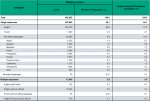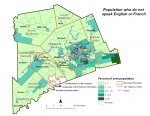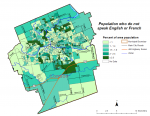Language
Language
English is the primary language in Middlesex-London. English was the single language spoken most often at home by 86.8% of the population of Middlesex-London in 2016. An additional 3.9% of the population spoke English as at least one of their home languages (Figure 1.8.1).
The percent of those who did not speak English at home in Middlesex-London in 2016 (9.4%) was a smaller percent than Ontario (16.6) (Figure 1.8.1).
A language other than English or French (i.e., a non-official language) was spoken at home on a regular basis by 9.0% of the population of Middlesex-London compared to 14.4% in Ontario (Figure 1.8.1).
French was spoken at home most often by 1,660 (0.4%) people in Middlesex-London in 2016. An additional 90 people spoke multiple languages including French (but not English) at home. In Ontario, the percent who spoke French at home was higher at 2.1% with an additional 0.1% who spoke multiple languages including French but not English at home (Figure 1.8.1).
Approximately 30 people in Middlesex-London identified that they spoke an Indigenous language at home in 2016 (e.g., Ojibwa, Oneida).1
Almost all of the population of Middlesex-London has knowledge of English or French. Only 1.4 % of the Middlesex-London population does not have knowledge of at least one of the official languages compared to 2.5% in Ontario (Figure 1.8.2).
Nearly 7% of people in Middlesex-London had knowledge of both English and French in 2016 (Figure 1.8.2).
Maps (Figures 1.8.3 and 1.8.4) show how the proportions of people who speak neither English nor French vary within Middlesex-London and the City of London. People that do not speak English or French are more concentrated in and around urban areas of Middlesex-London.
Interpretive notes:
Canada’s official languages are English and French. Middlesex-London Health Unit is a designated French language service area, and therefore endeavors to provide services in both official languages. Home language provides an indicator of cultural diversity in the community as well as identifying potential preferences for service or information. Language spoken at home may not be the same as language spoken at work, school, or with friends. Therefore, it is important to consider both home language and knowledge of official languages to get a full picture of potential language use.
Ontario Public Health Standards: Requirements for Programs, Services, and Accountability
Population Health Assessment and Surveillance Protocol, 2018
References:
- Statistics Canada. Middlesex-London Health Unit, [Health region, December 2017], Ontario and Ontario [Province] (table). Census Profile. 2016 Census. Statistics Canada Catalogue no. 98-316-X2016001 [Internet] Ottawa, ON: Government of Canada; [updated 2017 Nov 29; cited 2018 Nov 30]. Available from:
https://www12.statcan.gc.ca/census-recensement/2016/dp-pd/prof/index.cfm?Lang=E
Last modified on: January 25, 2019
Jargon Explained
Home Language
The language(s) spoken most often at home.
Knowledge of Official Languages
Some knowledge of English, French or both.


